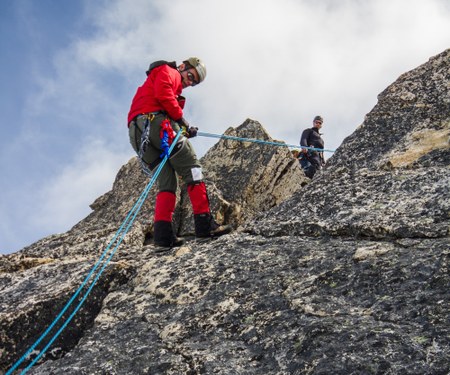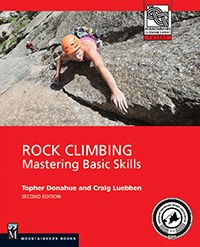
Helmets aren't just decoration for your head
"OUCH!" screamed my instructor at the rock field trip last month. A golf ball-sized piece of Mt. Erie had just bounced off the top of her helmet and she asked her students why no one had been screaming the "rock, rock, rock!" warning. In this case, however, no climbers were above her and as best as we could figure out, an empty rope had knocked it loose earlier in a climb and it finally fell after the climber was off rappel. "Thank you" to Instructor Sherrie Trecker for that perfect demonstration why you always wear your helmet at the crag - even if you're not belaying or on a rope. Because of that, one modest "ouch" was all Sherrie had to say to convey her level of surprise: no injury was caused.
Rockfall happens...a lot
The Cascade range in Washington is notorious for loose rock. Of the 305 trip surveys completed by Mountaineers participants in June 2015, 8 of the 18 safety concern incidents reported had to do with rockfall.
The remaining incidents were scattered among other causes (too steep a hike for one person, too long a wait at a summit with a large group, scrapes from a fall, a successful self-arrest, dry-suit that was too tight, etc.). Falling rock was, by far, the largest commonality among all of the safety concerns reported out of ALL Mountaineers activities in June. However, in the climbing community in general, "when it comes to helmets and climbers, inconsistency is everywhere. Most ice climbers and mountaineers wear helmets, as do many traditional rock climbers. But far fewer rock climbers don lids for short climbs, especially sport routes." - Climbing Mag article on helmet use
Our courses do a great job of emphasizing this as a risk factor AND of instilling the habit of wearing your helmet. But here are some of the more finite points to remember from one of our best books on the subject.
Tips for Staying Safe from Rockfall (and other such precipitation)
From "Rock Climbing: Mastering Basic Skills," page 230. by Mountaineers Books
Bad Rock
Loose rocks - those that fall naturally from cliffs, and the barely attached blocks, flakes, and holds that you must sometimes climb past - present one of the biggest hazards to climbers. Rotten, decomposing, or soft rock can also be dangerous. Good research can help you avoid routes littered with bad, loose, or rotten rock. Still, many classic climbs have short stretches of sketchy rock, and the walls that you climb change every day.
Coping with bad rock:
- Locate the belayer in a sheltered area. The belay stance needs to be sheltered from direct blows and rock that shatters and deflects on the way down.
- Wear a helmet.
- Keep the climbing rope away from the rockfall zones.
- Constantly evaluate rock quality while you climb. Look for cracks, detached blocks, and loose flakes.
- Warn your belayer and other climbers when you're climbing in loose rock.
- If you anticipate bad rock above, set good protection in the solid rock below.
- Test suspect handholds and footholds buy hitting them with your palm or kicking them. Beware if the rock sounds hollow.
- Avoid weighting loose holds. If you've determined that a loose hold seems reasonable and you must use it, pull or push down, do not pull out.
- Selectively distribute your weight among the various holds.
- Don't place protection behind loose blocks or flakes. If you fall, you might pull the rock down behind you, jeopardizing your belayer, your rope, and yourself.
- Route the rope so it stays away from loose holds (and sharp edges).
- You can mark a dangerously loose block or hold with a chalk-marked "X" to warn your partner and others (or call down to them if they are in sight), but don't go overboard marking holds; first appearances can be deceiving.
- Don't climb directly below other parties, even if it means walking away from a super classic route that you just hiked 5 miles to climb. Sometimes, waiting for a party above to traverse out of the way may allow you to safely climb with another team above. In Europe, and now in popular areas in North America, climbing below other parties is common, but the frequency of this practice has not decreased the risk.
ROCK, ROCK, ROCK, ROCK, ROCK, ROCK!!!*
...until it STOPS moving! You may just save a life (including your own).
 Chris Williams
Chris Williams
